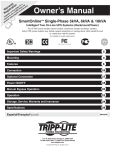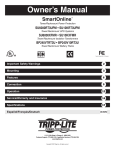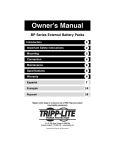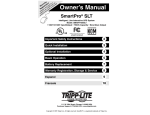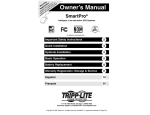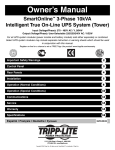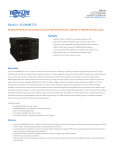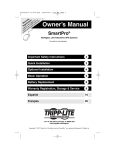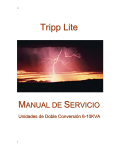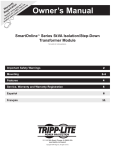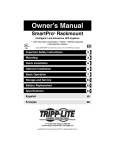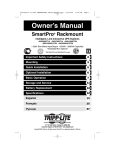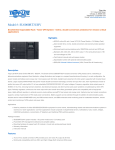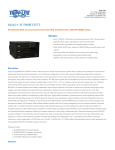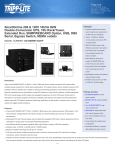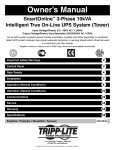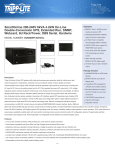Download Tripp Lite 5kVA User's Manual
Transcript
y nt ion y for a Lite nty a r p a ar trat e todaE Trip /warr W is -lin RE om g n F .c Re ster owin aipplite gi to .tr Re ce ww an ! w ch uct od pr Owner’s Manual SmartOnline Single-Phase 5kVA, 6kVA & 10kVA ™ Intelligent True On-Line UPS Systems (Rackmount/Tower) For all UPS system modules (power module, transformer module and battery module). Select UPS system modules may include separate instruction or warning sheets which should be used in conjunction with this manual. Important Safety Warnings 2 Mounting 3 Features 5 Connection 10 Optional Connection 17 Power ON/OFF 18 Manual Bypass Operation 20 Operation 21 Storage, Service, Warranty and Insurance 24 Specifications 25 Español/Français/Ðóññêèé 26/51/76 1111 W. 35th Street • Chicago, IL 60609 USA Customer Support: (773) 869-1234 • Application Services: (773) 869-1236 • www.tripplite.com Copyright ©2005 Tripp Lite. All rights reserved. Important Safety Warnings SAVE THESE INSTRUCTIONS. This manual contains important instructions and warnings that should be followed during the installation and maintenance of all Tripp Lite SmartOnline Rackmount/Tower UPS Systems and their batteries. UPS Location Warnings • Install your UPS indoors, away from excess moisture or heat, direct sunlight, dust and conductive contaminants. • Install your UPS in a structurally sound area. Your UPS is extremely heavy; take care when moving and lifting the unit. • Only operate your UPS at indoor temperatures between 32° F and 104° F (between 0° C and 40° C). For best results, keep indoor temperatures between 62° F and 84° F (between 17° C and 29° C). • Leave adequate space around all sides of the UPS for proper ventilation. • Do not install the UPS near magnetic storage media, as this may result in data corruption. UPS Connection Warnings • The power supply for this unit must be single-phase rated in accordance with the equipment nameplate. It also must be suitably grounded. Equipment Connection Warnings • Do not use Tripp Lite UPS Systems in life support applications in which a malfunction or failure of a Tripp Lite UPS System could cause failure or significantly alter the performance of a life support device. • Connect your UPS power module’s and/or transformer module’s grounding terminal to a grounding electrode conductor. • The UPS is connected to a DC energy source (battery). The output terminals may be live when the UPS is not connected to an AC supply. Maintenance Warnings • Your UPS power module, transformer module and battery module(s) do not require routine maintenance. Do not open them for any reason. There are no user-serviceable parts inside. Battery Warnings • Do not operate your UPS without connecting it to an external battery module. • Connect only Tripp Lite battery modules (of the correct type and voltage) to your UPS power module's external battery connector. • Batteries can present a risk of electrical shock and burn from high short-circuit current. Observe proper precautions. Do not dispose of the batteries in a fire. Do not open the UPS or batteries. Do not short or bridge the battery terminals with any object. Unplug and turn off the UPS before performing battery replacement. Use tools with insulated handles. There are no user-serviceable parts inside the UPS. Battery replacement should be performed only by authorized service personnel using the same number and type of batteries (sealed Lead-Acid). The batteries are recyclable. Refer to your local codes for disposal requirements or in the USA only call 1-800SAV-LEAD or 1-800-8-BATTERY (1-800-822-8837) or visit www.rbrc.com for recycling information. Tripp Lite offers a complete line of UPS System Replacement Battery Cartridges (R.B.C.).Visit Tripp Lite on the Web at www.tripplite.com/support/battery/index.cfm to locate the specific replacement battery for your UPS. • Fuses should be replaced only by factory authorized personnel. Blown fuses should be replaced only with fuses of the same number and type. • Service and repair should be done only by trained personnel. Prior to any service work performed on hardwired power modules, they should be turned off or manually bypassed via the transformer. Prior to any service work performed on power modules that plug directly into wall outlets, they should be turned off and unplugged. Note that potentially lethal voltages exist within this unit as long as the battery supply is connected. • Do not connect or disconnect battery module(s) while the UPS is operating from the battery supply or when the transformer module is not in bypass mode (if your UPS system includes a transformer module with a bypass switch). • During "hot-swap" battery module replacement your UPS will be unable to provide battery backup in the event of a blackout. 2 Mounting (Rack) Mount your equipment in either a 4-post or 2-post rack or rack enclosure.The user must determine the fitness of hardware and procedures before mounting. If hardware and procedures are not suitable for your application, contact the manufacturer of your rack or rack enclosure. The procedures described in this manual are for common rack and rack enclosure types and may not be appropriate for all applications. WARNING! All UPS System modules are extremely heavy! Use caution while lifting and mounting! User must properly stabilize the module while lifting and mounting! 4-Post Mounting 1 Connect the two segments of each shelf A using the included attached screws and wing nuts B . Leave the screws slightly loose so that the shelves can be adjusted in the next step. B 1 2 B A Adjust each shelf to fit your rack, then mount them in the lowest available space of your rack with the screws, nuts and washers provided C . Note that the support ledges should face inward. Tighten the wingnuts that connect the shelf segments D . C D 2 3 Attach mounting ears E to the front mounting holes of your equipment F using the screws provided G . The ears should face forward. F E 3 4 Using an assistant, lift your equipment and slide it onto the mounting shelves. Attach your equipment to the rack by passing the screws, nuts and washers (user-provided) H through its mounting ears and into the rack rails. H 4 2-Post (Telecom) Mounting To mount your equipment in a 2-post rack, you must purchase a Tripp Lite 2-Post Rackmount Installation Kit (model: 2POSTRMKIT, sold separately) for each module installed. See the Installation Kit's owner's manual for complete mounting instructions. 3 G Mounting (Tower) All modules can be mounted in an upright, tower position when used with optional adjustable base stands, sold separately from Tripp Lite (model #: 2-9USTAND). When mounting modules on the adjustable base stands, make sure that the power module's control panel is towards the top. Also, if you are installing a transformer module, place it between the power module and its battery module. WARNING! All UPS System modules are extremely heavy! Use caution while lifting and mounting! User must properly stabilize the module while lifting and mounting! Rotate the power module’s Control Panel to view it easier while the UPS is tower mounted. Insert a small screwdriver, or other tool, in the slots on either side of the Control Panel. Pop the panel out; rotate it; and pop the panel back into place. 4 Features There are three separate UPS system modules available from Tripp Lite (a power module, a transformer module and a battery module) used in a variety of combinations. Familiarize yourself with the location and function of the features on each module before installing and operating your UPS system. The power module is the only module which includes front panel features. 11 Power Module Front Panel Controls 10 9 8 7 6 12 12 1 2 3 4 5 1. LCD DISPLAY: This backlit (16 × 2 character) dot matrix display indicates a wide range of UPS operating conditions and diagnostic data. It also displays UPS settings and options when the UPS is in setup mode. 2. ON/MUTE BUTTON: Press this button and hold it until you hear a beep to turn the UPS system’s inverter ON. If the UPS’s battery alarm is sounding, press this button to silence it. 3. SCROLL DOWN/EXIT SETUP BUTTON: This button allows you to browse through different options and power readings on the LCD display. Momentarily pressing it causes the LCD screen to display a different power reading (see “Operation”). Pressing it and the SCROLL UP Button together puts the UPS in setup mode, where this button is used to scroll through setup options and to exit setup mode. 4. SCROLL UP/SELECT BUTTON: This button allows you to browse through different options and power readings on the LCD display. Momentarily pressing it causes the LCD screen to display a different power reading (see “Operation”). Pressing it and the SCROLL DOWN Button together puts the UPS in setup mode, where this button is used to select setup options. 5. OFF BUTTON: Press this button until you hear a beep to turn the UPS system’s inverter OFF. 6. O/P (OUTPUT) LED: This green light will illuminate to indicate your UPS is supplying AC power to connected equipment. 7. DC/AC (INVERTER) LED: This green light will illuminate to indicate the UPS’s DC/AC inverter is activated. 8. BYPASS LED: This green light will illuminate when the UPS is providing filtered mains power without engaging its converter or inverter. If this LED is lit, connected equipment will not receive battery power in the event of a blackout. 9. AC/DC (Converter) LED: This green light will illuminate to indicate the UPS’s AC/DC converter is charging the connected battery pack(s). 10. BATTERY LED: This red light will illuminate when the UPS is discharging the battery to provide connected equipment with AC power. An alarm will sound which can be silenced by pressing the ON/MUTE Button. This LED will remain lit after the alarm is silenced. 11. I/P (INPUT) LED: This green light will illuminate to indicate an AC input supply is present. 12. ACCESS SLOTS: To rotate the controls, insert a flathead screwdriver into these slots and gently lever the panel out. Taking care not to excessively twist or yank the cables connecting the controls to the rest of the UPS, turn the controls to the desired orientation and reinsert them. 5 Features (Rear Panel) see page 9 for feature descriptions 5kVA Power Module 11 12 12 7 8 9 6 10 3 13 14 13 5kVA Transformer Module 25 19 25 26 24 25 5kVA Battery Module* 28 * The 5kVA Power Module is shipped with a Battery Module which is not expandable; however, the Power Module is fully compatible with Tripp Lite Battery Modules which are expandable (Tripp Lite model # BP240V10RT-3U, sold separately) if extended runtime is required. 6 24 Features (Rear Panel) see page 9 for feature descriptions 5 6kVA Power Module 4 1 2 7 8 9 6 10 3 6kVA Transformer Module 16 15 20 17 19 20 6kVA Battery Module* * Expandable Battery Module (Tripp Lite model # BP240V10RT-3U) shown. Depending on the model ordered, the 6kVA Power Module may have been shipped with an expandable Battery Module (like the one shown above) or one which is not expandable. All 6kVA Power Modules, however, are fully compatible with BP240V10RT-3U Battery Modules (sold separately) if extended runtime is required. 28 7 27 22 23 Features (Rear Panel) see page 9 for feature descriptions 5 6 10kVA Power Module 4 3 7 8 9 1 10 21 10kVA Transformer Module 16 2 15 20 18 10kVA Battery Module * Expandable Battery Module (Tripp Lite model # BP240V10RT-3U) shown. Depending on the model ordered, the 10kVA Power Module may have been shipped with an expandable Battery Module (like the one shown above) or one which is not expandable. All 10kVA Power Modules, however, are fully compatible with BP240V10RT-3U Battery Modules (sold separately) if extended runtime is required. 28 27 8 19 22 23 Features (Rear Panel) continued Power Module Feature Description 1. Output Terminal Block (6kVA and 10kVA models only): Use these terminals to connect your power module to your equipment or to the transformer module. Unscrew and remove the cover over the block for access. 2. Input Terminal Block (6kVA and 10kVA models only): Use these terminals to connect your power module to utility power or to the transformer module. Unscrew and remove the cover over the block for access. 3. External Battery Connector: Use this to connect one or more Tripp Lite battery modules to the power module. Remove the cover for access. The power module will not start without a connection to a charged battery module. Refer to the battery module owner’s manual for connection instructions and safety warnings. 4. AC Input Breaker (6kVA and 10kVA models only): One double-pole circuit breaker controls input power to the power module. 5. AC Output Breaker (6kVA and 10kVA models only): One double-pole circuit breaker controls output power from the power module. 6. Exhaust Fan: This cools and ventilates the inside of the power module. 7. Accessory Slot: Remove the small cover panel to install optional accessories to remotely control and monitor your UPS system. Visit Tripp Lite on the Web (www.tripplite.com) to learn about available SNMP, network management and connectivity products that may be installed in this slot. 8. EPO (Emergency Power Off) Port: The power module features an EPO port that may be used to connect the power module to a contact closure switch to enable emergency power off. See “Optional Connection” section for details. 9. RS-232 Communication Port: This female DB9 serial port may be used to connect your UPS to a workstation or server. It uses RS-232 protocol to communicate with a connected computer. It is used with Tripp Lite software and the included serial cable to monitor and manage the UPS remotely over a network and to automatically save open files and shut down equipment during a blackout. See “Optional Connection” for details. 10. Dry Contact Interface Port: This female DB9 port sends contact-closure signals to indicate line-fail and low-battery status. See “Optional Connection” for details. 11. AC Output 1 Breaker (5kVA models only): One double-pole circuit breaker controls output power from the 5kVA power module's AC receptacles labelled "Output 1." 12. AC Output 1 Receptacles (5kVA models only): Accepts direct plug-in connection of NEMA L6-20P equipment plugs. 13. AC Output 2 Receptacles (5kVA models only): Accepts direct plug-in connection of NEMA L6-30P equipment plugs. Either receptacle also accepts direct plug-in connection of transformer connector cable (if used). 14. AC Input Cord (5kVA models only): Connects directly to wall receptacle providing 200/208/220/230 or 240V AC utility power. Transformer Module Feature Description (Transformer Module not included with hardwire (HV) models.) 15. Utility Input Terminal Block (6kVA and 10kVA models only): Use these terminals to connect your transformer module to utility power. Unscrew and remove the cover over the block for access. 16. Equipment Output Terminal Block (6kVA and 10kVA models only): Use these terminals to connect your equipment to the transformer module. Unscrew and remove the cover over the block for access. 17. Cable for Power Module Connection (6kVA models only): Connects the transformer module to the power module’s input/output after the power module’s terminal blocks have been removed. See “Connection” section for details. 18 Hardwire Terminal Block for Power Module Connection (10kVA models only): Use these terminals to connect the transformer module to the power module’s input and output terminal blocks. See “Connection” section for details. 19. Overtemperature Reset Breaker: This circuit breaker trips if the unit’s temperature climbs too high. 20. AC to UPS Breaker (6kVA and 10kVA models only): One double-pole circuit breaker controls the transformer module’s power output to the UPS. 21. Output Breaker (6kVA and 10kVA models only): One triple-pole circuit breaker controls the transformer module’s power output to connected equipment. 22. Manual Bypass Switch (6kVA and 10kVA models only): This red and yellow dial is used to circumvent the power module while still supporting connected equipment when performing power module maintenance. While this switch is on BYPASS, connected equipment will receive filtered AC mains power from the transformer module, but the equipment will not receive battery power in the event of a blackout. See “Manual Bypass Operation” section for complete bypass procedure. WARNING! For qualified service personnel only. Failure to follow the bypass procedure completely will not adequately power down the UPS power module, resulting in the continued risk of death or injury from potential contact with high voltage. 9 Features (Rear Panel) continued 23. Input Voltage Select Switch (6kVA and 10kVA models only): Use this switch to set the transformer module's input voltage (either 200V AC, 208V AC or 240V AC). See “Connection” section for details. 24. AC Output Receptacles (5kVA models only): Accepts direct plug-in connection of NEMA 5-15P or NEMA 5-20P equipment plugs. 25. AC Output Breakers (5kVA models only): Push-button breakers control output power to transformer module's AC Output Receptacles which are directly adjacent. 26. Cable for Power Module Connection (5kVA models only): Plugs directly into either of the 5kVA power module's AC Output 2 Receptacles. NOTE: this cable should only be plugged into the 5kVA power module. Battery Module Feature Description 27. Input Connector (select Battery Modules only): Use this connector to daisy chain additional battery modules onto the first. Remove the cover panel for access. Refer to the battery module owner’s manual for connection instructions and safety warnings. 28. Output Cable: Use this cable to connect the battery module to the power module or to another battery module. The power module will not start without a connection to a charged battery module. Refer to the battery module owner’s manual for connection instructions and safety warnings. Connection Hardwiring Cautions (6kVA & 10kVA models only) • Wiring must be done by a qualified electrician. • The UPS power module may be installed on its own or connected to an isolation transformer module. Both applications require the power module to be connected to a battery module. • When making wiring connections, observe the cable connection regulations appropriate to your area [e.g. National Electrical Code (NEC) in the U.S.] at all times. Be sure to install an easily accessible disconnect switch in your installation wiring so you may cut off the UPS’s AC input during fires and other emergencies. Ensure that cables are fitted with cable sleeves and are secured by connector clamps. Tighten connections with a torque of not less than 24-28 inch-pounds (2.7-3.2 NM). • Make sure that your equipment is properly grounded. • Using cables of improper size may damage your equipment and cause fire hazards. Choose appropriate cabling and protection circuits to make wiring connections (Ground conductors must be the same size and type as the power conductors used): 6kVA Models 10kVA Models RATED INPUT CURRENT 200 - 240 (1Ø, 2-Wire + PE) 30A 8 AWG (10mm2) 50A 6 AWG (16mm2) RATED OUTPUT CURRENT 200 - 240V (1Ø, 2-Wire + PE) 30A 8 AWG (10mm2) 50A 6 AWG (16mm2) RATED OUTPUT CURRENT 120V (1Ø, 2-Wire + PE) 2 × 30A 8 AWG (10mm2) 2 × 50A 6 AWG (16mm2) OUTPUT PROTECTION CIRCUIT 30A 63A Connecting Modules to Each Other and to Utility Power and Equipment There are three separate UPS system modules available from Tripp Lite (a power module and a battery module, which are required in all applications, and a transformer module) used in a variety of combinations. Follow the connection procedure below which matches the combination of modules which you plan on installing. 10 Connection continued Connection Combination #1: Power Module (5kVA) + Battery Module 1 5kVA Power Module Shown Plug your equipment into the power module. Plug your equipment power cords A directly into the power module's AC Output Receptacles B . B A 1 2 Plug the power module into a wall receptacle. Plug the power module's AC input cord C directly into a wall receptacle D providing 200/208/220/230 or 240V AC utility power. C D 2 3 Connect the battery module to the power module. Consult the owner's manual that came with your battery module. Fully insert the connector on the end of the battery module's cable E into the connector on the rear panel of the power module F . Small sparks may occur; this is normal. NOTE: the power module does not contain internal batteries and will not start until a battery module is connected. The battery modules are fully charged prior to shipping. However, before expecting full backup capability (particularly if the battery module has been stored for an extended period) after the UPS system is connected to a utility power source, allow the battery module to recharge for 12 hours. Once the UPS system is in use, it will charge the batteries and maintain the charge level automatically. NOTE: The 5kVA Power Module is shipped with a Battery Module which is not expandable; however, the Power Module is fully compatible with Tripp Lite Battery Modules which are expandable (Tripp Lite model # BP240V10RT-3U, sold separately) if extended runtime is required. 11 F 3 E Connection continued Connection Combination #2: Power Module (5kVA) + Transformer Module (5kVA) + Battery Module 1 5kVA Power Module Shown Plug the transformer module into the power module. Plug the transformer module's connector cable A directly into either of the 5kVA power module's AC Output 2 Receptacles B . NOTE: this cable should only be plugged into the 5kVA power module. B 1 2 Plug your equipment into the power module and transfer module. Plug your 200/208/220/230/240V AC equipment power cords C directly into the power module's AC Output Receptacles D . Plug your 120V AC equipment power cords E directly into the transformer module's AC output receptacles F . C D E 2 3 A F Plug the power module into a wall receptacle. Plug the power module's AC input cord G directly into a wall receptacle H providing 200/208/220/230 or 240V AC utility power. H G 3 4 Connect the battery module to the power module. Consult the owner's manual that came with your battery module. Fully insert the connector on the end of the battery module's cable I into the connector on the rear panel of the power module J . Small sparks may occur; this is normal. NOTE: the power module does not contain internal batteries and will not start until a battery module is connected. The battery modules are fully charged prior to shipping. However, before expecting full backup capability (particularly if the battery module has been stored for an extended period) after the UPS system is connected to a utility power source, allow the battery module to recharge for 12 hours. Once the UPS system is in use, it will charge the batteries and maintain the charge level automatically. NOTE: The 5kVA Power Module is shipped with a Battery Module which is not expandable; however, the Power Module is fully compatible with Tripp Lite Battery Modules which are expandable (Tripp Lite model # BP240V10RT-3U, sold separately) if extended runtime is required. 12 J I 4 Connection continued Connection Combination #3: Power Module (either 6kVA or 10kVA) + Battery Module(s) 1 6kVA Power Module Shown Hardwire the power module to your equipment. A Using a screwdriver, remove the top of the box A covering the power module’s input and output terminals. Pass a user-supplied cable through the terminal box’s left knockout B and connect it to the power module’s output terminals. Connect the other end of the cable to your equipment. B 1 2 Hardwire the power module to a utility power source. Pass a user-supplied cable through the box’s right knockout C and connect it to the power module’s input terminals. Replace the top of the terminal box. Connect the other end of the cable to a utility power source. C 2 3 Connect the battery module to the power module. Consult the owner’s manual that came with your battery module. Fully insert the connector on the end of the battery module’s cable D into the connector on the rear panel of the power module E . Small sparks may occur; this is normal. NOTE: the power module does not contain internal batteries and will not start until a battery module is connected. The battery modules are fully charged prior to shipping. However, before expecting full backup capability (particularly if the battery module has been stored for an extended period) after the UPS system is connected to a utility power source, allow the battery module to recharge for 12 hours. Once the UPS system is in use, it will charge the batteries and maintain the charge level automatically. If needed, connect additional battery modules in a daisy-chain with each module’s cable inserted into the previous module’s connector F . 13 E F D 3 Connection continued Connection Combination #4: Power Module (6kVA) + Transformer Module (6kVA) + Battery Module(s) 1 Connect the power module to the transformer module. Using a screwdriver, remove the entire box A covering the power module’s input and output terminals. Remove the screws on either side of the terminals. Grip the terminals B and slide them out until you can view the cable connector release tab C . Press the tab down and pull on the cables to release them from the internal connector D . Remove the terminals. Insert the connector cable from the transformer module E into the internal connectors in the power module’s terminal box until the release tab clicks in place. Replace the screws around the plate. Although they are not needed, retain the power module’s terminals and terminal box cover in case you plan to operate the power module without the transformer module at a future date. A B D C 1 NORMAL BY PASS E 1 2 Hardwire the transformer module to your equipment. Using a screwdriver, remove the top of the box F covering the transformer module’s input and output terminals. Pass a user-supplied cable through the box’s left knockout G and connect it to the transformer module’s output terminals. See the AC Output Voltage Diagram H to determine which terminal connections will provide voltage appropriate to your application. Connect the other end of the cable to your equipment. F NORMAL BY PASS G 2 AC OUTPUT VOLTAGE DIAGRAM 208V 240V 120V 120V G H 3 Hardwire the transformer module to a utility power source. Pass a user-supplied cable through the box’s right knockout I and connect it to the transformer module’s input terminals. Replace the top of the box covering the transformer module’s terminals. Connect the other end of the cable to a utility power source. NORMAL BY PASS 3 Connection Combination #4 continued on next page 14 I Connection 4 continued Select the transformer module’s input voltage. Using a screwdriver, remove the panel covering the transformer module’s Input Voltage Select Switch J . Set the switch to match your facility’s input voltage. Then, use the power module’s front panel switches to configure input voltage on the LCD Display (see “Configure your UPS’s input and output” in the “Power ON/OFF” section on page 14). IMPORTANT NOTE: if your facility’s input voltage is 200V AC, set the transformer module’s switch to 240V AC, but configure the power module to 200V AC. If your facility’s input voltage is either 208V AC or 240V AC, the transformer module and power module settings must match. The factory default settings for both modules is 208V. See chart below. Your Facility's Input Voltage 240V AC 208V AC 200V AC Transformer Module Input Voltage Setting (Rear Panel Switch) 240V AC 208V AC 240V AC NORMAL 240V AC BY PASS 208V AC J 4 Power Module Input Voltage Setting (Front Panel Switches/LCD Display) 240V AC 208V AC 200V AC L K NORMAL BY PASS 5 Connect the battery module to the power module. Consult the owner’s manual that came with your battery module. Fully insert the connector on the end of the battery module’s cable K into the connector on the rear panel of the power module L . Small sparks may occur; this is normal. NOTE: the power module does not contain internal batteries and will not start until a battery module is connected. The battery modules are fully charged prior to shipping. However, before expecting full backup capability (particularly if the battery module has been stored for an extended period) after the UPS system is connected to a utility power source, allow the battery module to recharge for 12 hours. Once the UPS system is in use, it will charge the batteries and maintain the charge level automatically. If needed, connect additional battery modules in a daisy-chain with each module’s cable inserted into the previous module’s connector M . Connection Combination #5: Power Module (10kVA) + Transformer Module (10kVA) + Battery Module(s) 1 A Hardwire the power module to the transformer module. Using a screwdriver, remove the top of the box A covering the power module’s input and output terminals. Remove the top of the box B covering the transformer module’s terminals. With supplied cable, connect the power module’s input and output terminals to the corresponding terminals on the transformer module’s “Hardwire Terminal Block for Power Module Connection” in the box’s right knockout C . 2 M 5 B NORMAL 1 C BY PASS Hardwire the transformer module to your equipment. Pass a user-supplied cable through the box’s left knockout D and connect it to the transformer module’s output terminals. See the AC Output Voltage Diagram E to determine which terminal connections will provide voltage appropriate to your application. Connect the other end of the cable to your equipment. NORMAL BY PASS D 2 AC OUTPUT VOLTAGE DIAGRAM 208V 240V 120V Connection Combination #5 continued on next page 120V G 15 E Connection 3 continued Hardwire the transformer module to a utility power source. Pass a user-supplied cable through the box’s middle knockout F and connect it to the transformer module’s input terminals. Connect the other end of the cable to a utility power source. Replace the top of the boxes covering the power module’s and transformer module’s terminals. NORMAL BY PASS F 3 4 Select the transformer module’s input voltage. Using a screwdriver, remove the panel covering the transformer module’s Input Voltage Select Switch G . Set the switch to match your facility’s input voltage. Then, use the power module’s front panel switches to configure input voltage on the LCD Display (see “Configure your UPS's input and output” in the “Power ON/OFF” section). IMPORTANT NOTE: if your facility's input voltage is 200V AC, set the transformer module’s switch to 240V AC, but configure the power module to 200V AC. If your facility’s input voltage is either 208V AC or 240V AC, the transformer module and power module settings must match. The factory default settings for both modules is 208V. See chart below. Your Facility’s Input Voltage 240V AC 208V AC 200V AC 5 Transformer Module Input Voltage Setting (Rear Panel Switch) 240V AC 208V AC 240V AC NORMAL 240V AC BY PASS 208V AC G 4 Power Module Input Voltage Setting (Front Panel Switches/LCD Display) 240V AC 208V AC 200V AC Connect the battery module to the power module. Consult the owner’s manual that came with your battery module. Fully insert the connector on the end of the battery module’s cable H into the connector on the rear panel of the power module I . Small sparks may occur; this is normal. NOTE: the power module does not contain internal batteries and will not supply power to connected equipment until a battery module is connected. The battery modules are fully charged prior to shipping. However, if the battery module has been stored for an extended period, after the UPS system is connected to a utility power source, allow the battery module to recharge for 12 hours. If needed, connect additional battery modules in a daisy-chain with each module’s cable inserted into the previous module’s connector J . 16 I H NORMAL BY PASS 5 J Optional Connection The following connections are optional. Your UPS system will function properly without these connections. RS-232 Serial Communication Connection Use the included cable to connect the power module’s “RS-232” port to the communication port on your computer. This will allow full network monitoring and control of your UPS system. Install on your computer the Tripp Lite PowerAlert Software appropriate to your computer’s operating system. Contact-Closure Communication Connection Use a user-supplied contact-closure DB9 cable to connect the power module’s “DryContact” port to the communication port on your computer or other equipment. This will allow basic contact-closure signals to be sent to and from the UPS. Refer to the following diagram and table to determine the signals carried by this port. Install on your computer the Tripp Lite PowerAlert Software appropriate to your computer’s operating system. DRY CONTACT INTERFACE DIAGRAM DRY CONTACT INTERFACE TABLE lm in. > 3.3 mA LOW BATTERY REMOTE SHUTDOWN SIGNAL FROM EXTERNAL BACK-UP NO NO COM COM NC NC 5 9 4 8 3 7 2 6 1 UPS Operating Pin 8,3 Pin 1,3 Pin 6,3 Mode Normal OPEN OPEN Back Up CLOSE * Low Battery CLOSE CLOSE * * * SIGNAL FROM COMPUTER Fault >2 sec 12 V MAXIMUM CAPACITY OF DRY CONTACT: AC250V/3A • DC30V/3A * * CLOSE * Inactive: may be in either state 0 EPO Port Connection This optional feature is only for those applications which require connection to a facility’s Emergency Power Off (EPO) circuit. When the power module is connected to this circuit, it enables emergency shutdown of the output. Using the included cable, connect the power module’s EPO port to a user-supplied remote switch. The pin assignments for the EPO port are shown in the following diagram. Note: if there is a short between pins 2 and 3, 2 and 5, 4 and 5, or 3 and 4, the UPS system will power off. EPO PIN ASSIGNMENT 12V X 1 2 3 4 1K 5 X 17 6 Power ON/OFF (5kVA models only) 1. Configure your UPS’s input and output: Put your UPS power module into setup mode by holding down both of its scroll buttons ( A and B ) at once. Scroll through the setup options (using A or B ) and select the appropriate setting for each of the following options using the “SELECT” button B . • Input & Output Voltage: Select 200, 208 or 240 VAC. • Output Frequency: Your UPS will autoselect 50 or 60 Hz to match the input. • Economy Mode: Your UPS can provide on-line operation with zero transfer time. It can also operate in a more energy-efficient line-interactive mode. Select Economy On to put the UPS in line-interactive mode. Select Economy Off to put the UPS in on-line mode. • After you have set these options, “exit” the setup mode with the scroll button A , then exit bypass mode by holding the ON button C down until you hear a beep. 2. Turn input to the UPS ON: Press and hold the power module's ON button C until you hear a beep to start your UPS in ON BATTERY mode. Note that some electronic equipment may draw more amps during startup; when starting from battery, consider reducing the initial load on the UPS. Your UPS will perform a brief self-test and show the results on the LCD Display D . See "Startup Self-Test" in the "Operation" section for the display sequence. 3. To turn the UPS power module and transformer module (if used) OFF: Press the power module's OFF button F until you hear a beep. Your load will still be energized. The inverter is now off, but your UPS is not fully deactivated. The LCD Display D will show BYPASS MODE. Turn the power module's Output Breaker E OFF. Unplug the power module's AC input cord from the wall outlet. If a transformer module is used, unplug its connector cable from the power module. Your load will no longer be energized, and the LCD Display D will be dark. E D C A B 5kVA Models (Front Panel) 5kVA Models 18 F Power ON/OFF (6kVA and 10kVA models only) 1. Configure your UPS’s input and output: Put your UPS power module into setup mode by holding down both of its scroll buttons ( A and B ) at once. Scroll through the setup options (using A or B ) and select the appropriate setting for each of the following options using the “SELECT” button B . • Input & Output Voltage: Select 200, 208 or 240 VAC. • Output Frequency: Your UPS will autoselect 50 or 60 Hz to match the input. • Economy Mode: Your UPS can provide on-line operation with zero transfer time. It can also operate in a more energy-efficient line-interactive mode. Select Economy On to put the UPS in line-interactive mode. Select Economy Off to put the UPS in on-line mode. • After you have set these options, “exit” the setup mode with the scroll button A , then exit bypass mode by holding the ON button C down until you hear a beep. 2. Turn input to the UPS ON: If the UPS power module is connected to a transformer module, turn the tranformer module’s AC-to-UPS and Output Circuit Breakers D on. Turn the UPS power module’s Input Circuit Breaker E on. Press the UPS power module’s ON button C until you hear a beep to begin inverter operation. If your AC input is not providing power normally, you may “cold start” your UPS from battery. (Your battery must be at least partially charged for this operation to succeed.) Press and hold the ON C button until you hear a beep to start your UPS in ON BATTERY mode. Note that some electronic equipment may draw more amps during startup; when starting from battery, consider reducing the initial load on the UPS. Your UPS will perform a brief self-test and show the results on the LCD Display F . See “Startup Self-Test” in the “Operation” section for the display sequence. 3. Turn UPS output ON: Turn the UPS power module’s Output Circuit Breaker G ON. If the UPS is connected to a transformer module, turn the transformer module’s Manual Bypass Switch H from BYPASS to NORMAL and its Output Circuit Breaker ON. Your UPS will now provide power to connected equipment. 4. To turn the UPS power module and transformer module OFF: Press the UPS power module’s OFF button I until you hear a beep. Your load will still be energized. The inverter is now off, but your UPS is not fully deactivated. The LCD Display F will show BYPASS MODE. Turn the UPS power module’s Input and Output Circuit Breakers ( E and G ) OFF. If the UPS is connected to a transformer module, turn the transformer module’s power AC-to-UPS and Output Circuit Breakers D OFF. Your load will no longer be energized, and the LCD Display F will be dark. G E G D D E NORMAL NORMAL BY PASS BY PASS H H 10kVA Models 6kVA Models F C B A I 6kVA & 10kVA Models (Front Panel) 19 Manual Bypass Operation (6kVA and 10kVA models only) (for power module maintenance or replacement) The following procedure only applies to UPS system configurations that include a 6kVA or 10kVA transformer module. The procedure details how to service or replace the power module while supplying equipment connected to the transformer module with utility power. NOTE: since the power module and battery module will be disconnected during the procedure, they will be unable to supply battery backup support to equipment connected to the transformer module in the event of a blackout. WARNING! For qualified service personnel only. Failure to follow this procedure completely will not adequately power down the UPS power module, resulting in the continued risk of death or injury from potential contact with high voltage. 1. Disable PowerAlert Software and disconnect communication cable from the power module’s communication ports A . 2. Turn transformer module’s Bypass Switch B to “BYPASS”. 3. Press power module’s OFF Button C , if power module is powered, until a beep is heard and a “BYPASS MODE” message is displayed in the LCD panel D . 4. Turn off the transformer module's double-pole AC to UPS breaker E . 5. Turn off the power module’s double-pole input breaker F and double-pole output breaker G . 6. Disconnect battery module cable from the power module’s battery connector H . 7. FOR 10kVA POWER MODULES ONLY: Use a voltage meter to check the cable connecting the power module’s terminal blocks I to the transformer module’s terminal blocks J to ensure the power module is no longer powered. Once it is no longer powered, remove the cabling. The power module is now safely powered down and maintenance/replacement can be performed. G G F H F A J A E E NORMAL NORMAL BY PASS BY PASS H I B B 10kVA Models (Rear Panel) 6kVA Models (Rear Panel) D C 6kVA & 10kVA Models (Front Panel) 20 Operation Startup Self-Test When you turn the UPS ON, it will enter Diagnostic Mode and perform a brief self-test lasting about 15 seconds. The results of the self-test are shown on the LCD screen in the sequence below. STARTED WITH AC INPUT COLD START* DIAGNOSTIC MODE FREQ OUT = XXHz DIAGNOSTIC MODE FREQ OUT = XXHz M M DIAGNOSTIC MODE INPUT AC OK DIAGNOSTIC MODE INPUT AC BAD M M DIAGNOSTIC MODE INPUT AC OK DIAGNOSTIC MODE INPUT AC BAD M M DIAGNOSTIC MODE BATTERY OK DIAGNOSTIC MODE BATTERY OK M M DIAGNOSTIC MODE CHARGER OK DIAGNOSTIC MODE AC/DC OK M M DIAGNOSTIC MODE AC/DC OK DIAGNOSTIC MODE TESTING INVERTER M M DIAGNOSTIC MODE TESTING INVERTER ON BATTERY MODE LOAD = XXX% X.XXKW M ONLINE MODE LOAD = XXX% X.XXKW *Note: If the UPS is cold started, its BATTERY LED will be lit. Failed Self-Test If a problem is detected during the self-test, the LCD will display a error message. If your UPS displays any of the following messages in its LCD, call Tripp Lite Technical Support at (773) 869-1234 for service. BAD BATTERY! CALL FOR SERVICE CHARGER FAILURE! CALL FOR SERVICE AC/DC FAILURE! CALL FOR SERVICE INVERTER FAILURE! CALL FOR SERVICE OUTPUT FAILURE! CALL FOR SERVICE FAN FAILURE! CALL FOR SERVICE 21 Operation continued Normal Operation During normal operation, the first line of your LCD Display shows which operating mode your UPS is in: Online, Economy, On Battery, or Bypass. Online mode: The UPS provides AC power while utility power is available and switches to On Battery mode instantly (zero transfer time) if AC power is interrupted. Economy mode: The UPS provides AC power at high efficiency while utility power is available and switches to On Battery mode quickly if AC power is interrupted. On Battery mode: The UPS provides AC power from battery backup so long as battery power lasts. It switches back to Online or Economy mode if utility power is available and shuts down if it runs out of battery power. Bypass mode: The UPS provides AC power while utility power is available. The UPS shuts down if AC power is interrupted. The second line of the LCD Display shows basic power conditions. Push the SCROLL buttons to browse through these basic power conditions in the sequence shown below. M XXXX MODE LOAD = XXX% X.XXKW M L XXXX MODE IN = XXXV XX.X Hz M L XXXX MODE OUT = XXXV XX.X Hz M L XXXX MODE BATTERY = XXXVDC M On Battery Alarm When in the On Battery mode, the UPS power module will beep to inform you that it is using battery power to support connected equipment. If its connected batteries are at more than half capacity, it will beep every two seconds. If its connected batteries are below half capacity, it will beep twice a second. If its connected batteries are nearly depleted, the UPS power module will beep continuously. To silence the On Battery Alarm, press the “ON/MUTE” button. Overload Messages When the UPS detects an output overload, its LCD will switch to the following display: OVERLOAD! LOAD = XXX% X.XXKW The UPS will then begin a countdown. If the UPS is still overloaded at the end of the countdown, the UPS will automatically go to Bypass Mode to protect its inverter. The duration of the countdown varies with the severity of the overload, as follows: Overload Condition 102% - 125% Countdown Duration 1 minute 125% - 150% >150% 30 seconds Immediate 22 Operation continued Bypass Messages While in Bypass Mode, the UPS monitors its input voltage and passes that input power along to connected equipment. The UPS will not provide battery backup in Bypass Mode. If the output voltage deviates from an acceptable range (between 15% higher and 20% lower than nominal), the UPS displays the condition on its LCD and stops supplying output power to its load. If power levels return to an acceptable level, the UPS resumes supplying power to the load, and its LCD reports that output voltage was too high or too low at one time, but has returned to nominal. BYPASS VOLTAGE CONDITIONS LCD DISPLAY MESSAGES >15% Higher Than Nominal NO OUTPUT BYPASS AC TOO HI >20% Lower Than Nominal NO OUTPUT BYPASS AC TOO LO Was Too High, Now Nominal BYPASS MODE BYPASS AC WAS HI Was Too Low, Now Nominal BYPASS MODE BYPASS AC WAS LO Shutdown Messages Your UPS will shut down and the LCD will display a message if it detects one of the following conditions. Note: During all these conditions, the “Input,” “Output” and “Bypass” LEDs will be illuminated. SHUTDOWN CONDITIONS LCD DISPLAY MESSAGES Extended Overload SHUT DOWN OVERLOAD XXX% Output Short Circuit SHUT DOWN O/P SHORT CIRCUIT Remote Shutdown Command (Via DB9) SHUT DOWN REMOTE COMMAND Remote Shutdown Command (Via EPO) SHUT DOWN EMERGENCY STOP! Internal Faults SHUT DOWN + DC BUS HIGH SHUT DOWN + DC BUS LOW SHUT DOWN - DC BUS HIGH SHUT DOWN - DC BUS LOW SHUT DOWN OVERTEMPERATURE 23 Storage, Service, Warranty, Warranty Registration and Insurance Storage Before storing your UPS, turn it completely OFF. If you store your UPS for an extended period of time, recharge the UPS batteries for 4 to 6 hours once every three months. Note: after you connect the UPS to utility power, it will automatically begin charging its batteries. If you leave your UPS batteries discharged for an extended period of time, they will suffer a permanent loss of capacity. Service Your SmartOnline UPS System is covered by the 2-year limited warranty period described below. A variety of Extended Warranty and On-Site Service Programs are also available from Tripp Lite. For more information on service, call Tripp Lite Customer Support at (773) 869-1234. Before returning your UPS for service, follow these steps: 1. Review the installation and operation instructions in this manual to ensure that the service problem does not originate from a misreading of the instructions. Also, check that the UPS System's circuit breaker(s) are not tripped. This is the most common cause of service inquiries which can be easily remedied by following the resetting instructions in this manual. 2. If the problem continues, do not contact or return the UPS to the dealer. Instead, call Tripp Lite at (773) 869-1233. A service technician will ask for the UPS's model number, serial number and purchase date and will attempt to correct the problem over the phone. 3. If the problem requires service, the technician will issue you a Returned Material Authorization (RMA) number, which is required for service. They will also discuss proper packaging and shipping procedures. Any damages (direct, indirect, special, incidental or consequential) to the UPS incurred during shipment to Tripp Lite or an authorized Tripp Lite service center is not covered under warranty. UPS Systems shipped to Tripp Lite or an authorized Tripp Lite service center must have transportation charges prepaid. Mark the RMA number on the outside of the package. If the UPS System is within the 2-year warranty period, enclose a copy of your sales receipt. Return the UPS for service using an insured carrier to the address given to you by the Tripp Lite service technician. 2-Year Limited Warranty WARRANTY REGISTRATION TRIPP LITE warrants its products including batteries to be free from defects in materials and workmanship for a period of two years from the date of initial purchase. After 90 days from the date of purchase, TRIPP LITE’s obligation under this warranty is limited to replacing parts on such defective products. To obtain service under this warranty, you must call TRIPP LITE or an authorized TRIPP LITE service center. Products must be returned to TRIPP LITE or an authorized TRIPP LITE service center with transportation charges prepaid and must be accompanied by a brief description of the problem encountered and proof of date and place of purchase. This warranty does not apply to equipment which has been damaged by accident, negligence or misapplication or has been altered or modified in any way. This warranty applies only to the original purchaser who must have properly registered the product within 10 days of purchase. The warranties of all TRIPP LITE surge suppressors are null and void if they have been connected to the output of any UPS system. The warranties of all TRIPP LITE UPS Systems are null and void if a surge suppressor has been connected to its output receptacles. EXCEPT AS PROVIDED HEREIN, TRIPP LITE MAKES NO WARRANTIES, EXPRESS OR IMPLIED, INCLUDING WARRANTIES OF MERCHANTABILITY AND FITNESS FOR A PARTICULAR PURPOSE. Some states do not permit limitation or exclusion of implied warranties; therefore, the aforesaid limitation(s) or exclusion(s) may not apply to the purchaser. Visit www.tripplite.com/warranty today to register the warranty for your new Tripp Lite product. You’ll be automatically entered into a drawing for a chance to win a FREE Tripp Lite product!* * No purchase necessary. Void where prohibited. Some restrictions apply. See website for details. EXCEPT AS PROVIDED ABOVE, IN NO EVENT WILL TRIPP LITE BE LIABLE FOR DIRECT, INDIRECT, SPECIAL, INCIDENTAL OR CONSEQUENTIAL DAMAGES ARISING OUT OF THE USE OF THIS PRODUCT, EVEN IF ADVISED OF THE POSSIBILITY OF SUCH DAMAGE. Specifically, TRIPP LITE is not liable for any costs, such as lost profits or revenue, loss of equipment, loss of use of equipment, loss of software, loss of data, costs of substitutes, claims by third parties, or otherwise. The policy of TRIPP LITE is one of continuous improvement. Specifications are subject to change without notice. FCC RADIO/TV INTERFERENCE NOTICE: Note: This equipment has been tested and found to comply with the limits for a Class A digital device, pursuant to Part 15 of the FCC Rules. These limits are designed to provide reasonable protection against harmful interference when operated in a commercial environment. This equipment generates, uses and can radiate radio frequency energy, and if not installed and used in accordance with the instruction manual, may cause interference to radio communications. Operation of this equipment is likely to cause harmful interference in which case the user will be required to correct the interference at his own expense. The user must use shielded cables and connectors with this product. Any changes or modifications to this product not expressly approved by the party responsible for compliance could void the user's authority to operate the equipment. Regulatory Compliance Identification Numbers For the purpose of regulatory compliance certifications and identification, your Tripp Lite product has been assigned a unique series number. The series number can be found on the product nameplate label, along with all required approval markings and information. When requesting compliance information for this product, always refer to the series number. The series number should not be confused with the marking name or model number of the product. This product designed and engineered in the USA. 24 Specifications The models listed below include a power module, one or two battery modules, and a transformer module. All models include all three types of modules, with the exception of hardwired (HV) models, which do not include transformer modules. Depending on the model ordered, the included battery module may be either expandable or nonexpandable. However, if extended runtime is required, all power modules are fully compatible with expandable Tripp Lite battery modules (Tripp Lite Model # BP240V10RT-3U, sold separately) Model Information Model #(s) Package Includes: Power Module SU5000RT3UHV* & SU5000RT3U SU6000RT3UHV* & SU6000RT3U (model: SU5000RT3UPM; series: AGPS5124) (model: BP240V5RT2U; series: AGBP5161) Non-expandable N/A (model: SU6000RT3UPM; series: AGSU60003U) (model: BP240V7RT3U; series: AGBP240V7RT3U) Non-expandable N/A SU6000RT3UXR SU10KRT3UHV* & SU10KRT3U (model: SU6000RT3UPM; (model: SU10KRT3UPM; series: AGSU60003U) series: AGSU100003U) Battery Module #1 (model: BP240V10RT-3U; (model: BP240V10RT-3U; series: AGBP240V7RT3U) series: AGBP240V7RT3U) Non-expandable EXPANDABLE Battery Module #2 (model: BP240V7RT3U; N/A series: AGBP240V7RT3U) EXPANDABLE Transformer Module (model: SU5000XFMRT2U; (model: SU6000XFMRRT3U; (model: SU6000XFMRRT3U; (model: SU10KXFMRRT3U; series: AGAC5125) series: AGSM6000SDRT3U) series: AGSM6000SDRT3U) series: AGSM10KSDRT3U) Approvals: All power modules (UL, cUL, NOM, CE, GOST, SASO, IRAM, FCC Class A). All battery modules except BP240V5RT2U (UL, cUL, NOM). All transformer modules (UL, cUL, NOM, FCC Class A) * Transformer module not included with hardwired (HV) models. Input Input Connection Type 10 ft. cord with L6-30P plug Hardwire Hardwire Hardwire Input Voltage Range 156V~276V Single Phase 156V~276V Single Phase 156V~276V Single Phase 156V~276V Single Phase Module Input Voltage 200/208/240V AC 200/208/240V AC 200/208/240V AC 200/208/240V AC Input Frequency 50/60 Hz ± 3 Hz 50/60 Hz ± 3 Hz 50/60 Hz ± 3 Hz 50/60 Hz ± 3 Hz Input Current 20A 22.6A 22.6A 40A Inrush Current <150A <150A <150A <200A Power Factor (Full Load) >0.97 >0.97 >0.97 >0.97 Efficiency (Full Load/On-Line) >87% >87% >87% >88% Power Module Circuit Breaker N/A 40A (2 pole) 40A (2 pole) 63A (2 pole) Transformer Module Circuit Breaker N/A 40A (2 pole) 40A (2 pole) 63A (2 pole) Output VA Watts (Power Factor: 0.7) Output Connection Type Waveform (On-Line) Waveform (On-Battery) Output Voltage (RMS) Output Frequency Voltage Regulation Max. Harmonic Distortion (Linear Full Load) (Non-Linear Full Load) Overload Capabilities 5000 3500 4 receptacles on power module (2 L6-20R and 2 L6-30R) & 12 receptacles on transformer module (5-15/20R) Sinewave Sinewave 120*/200/208/240V AC 50/60 Hz (± 0.2 Hz on battery) ±3% 6000 6000 4200 4200 Hardwire Hardwire Optional corded backplate outlet kits available: SUPDM11 (SU6000RT3UHV); SUPDM12 (SU6000RT3U & SU6000RT3UXR); SUPDM13 (SU6000RT3U & SU6000RT3UXR); SUPDM15 (SU6000RT3U & SU6000RT3UXR); SUPDM16 (SU6000RT3U and SU6000RT3UXR) Sinewave Sinewave Sinewave Sinewave 100/120/200/208/240V AC 100/120/200/208/240V AC 50/60 Hz (± 0.2 Hz on battery) 50/60 Hz (± 0.2 Hz on battery) ±3% ±3% <3% <3% <3% <6% <6% <6% 102% (continuous) 102% (continuous) 102% (continuous) 102%~125% (1 min.) 102%~125% (1 min.) 102%~125% (1 min.) 125%~150% (30 sec.) 125%~150% (30 sec.) 125%~150% (30 sec.) >150% (Immediate) >150% (Immediate) >150% (Immediate) Short Circuit Capability 90A 90A* 90A* Power Module Circuit Breaker 20A (2 pole) 40A 40A Transformer Module* Circuit Breaker Four 20A (single pole) 30A (3 pole) 30A (3 pole) Crest Factor 3:1 3:1 3:1 * The short circuit capability at 1ø 2W 120V for the SU6000RT3U and SU6000RT3UXR is greater than 180A, and for the SU10KRT3U is greater than 320A. Operation On-Line Transfer Time (Line to Battery, Battery to Line) Audible Noise (Full Load @ 1 m) 0 ms. <50 dBA 0 ms <50 dBA 10000 7000 Hardwire Sinewave Sinewave 100/120/200/208/240V AC 50/60 Hz (± 0.2 Hz on battery) ±3% <3% <6% 102% (continuous) 102%~125% (1 min.) 125%~150% (30 sec.) >150% (Immediate) 160A* 63A 63A (3 pole) 3:1 0 ms <55 dBA 0 ms <55 dBA Indicators Includes an LCD Display and LEDs (I/P (input), BATTERY, AC/DC, BYPASS DC/AC, O/P (output)). Communications Includes an RS-232 DB9 female connector, a dry contact DB9 female connector and an accessory slot. Physical Specifications Unit Dimensions (H x W x D) Power Module Battery Module #2 (if applicable) 5.25 (3U) x 17.5 x 26 in. [13.4 x 44.5 x 66 cm.] 3.5 (2U) x 17.5 x 20.75 in. [8.9 x 44.5 x 52.7 cm.] 3.5 (2U) x 17.5 x 22.50 in. [8.9 x 44.5 x 52.7 cm.] N/A 5.25 (3U) x 17.5 x 22.5 in. [13.4 x 44.5 x 57.2 cm.] 5.25 (3U) x 17.5 x 26 in. [13.4 x 44.5 x 66.1 cm.] 5.25 (3U) x 17.5 x 22.5 in. [13.4 x 44.5 x 57.2 cm.] N/A 5.25 (3U) x 17.5 x 22.5 in. [13.4 x 44.5 x 57.2 cm.] 5.25 (3U) x 17.5 x 26 in. [13.4 x 44.5 x 66.1 cm.] 5.25 (3U) x 17.5 x 22.5 in. [13.4 x 44.5 x 57.2 cm.] 5.25 (3U) x 17.5 x 22.5 in. [13.4 x 44.5 x 57.2 cm.] 5.25 (3U) x 17.5 x 22.5 in. [13.4 x 44.5 x 57.2 cm.] 5.25 (3U) x 17.5 x 26 in. [13.4 x 44.5 x 66.1 cm.] 5.25 (3U) x 17.5 x 22.5 in. [13.4 x 44.5 x 57.2 cm.] N/A Shipping Weight Power Module Transformer Module* Battery Module #1 Battery Module #2 (if applicable) 58 lb. [27 kg.] 60 lb. [28 kg.] 138 lb. [63 kg.] N/A 58 lb. [27 kg.] 124 lb. [57 kg.] 160 lb. [73 kg.] N/A 58 lb. [27 kg.] 124 lb. [57 kg.] 160 lb. [73 kg.] 160 lb. [73 kg.] 68 lb. [31 kg.] 124 lb. [57 kg.] 160 lb. [73 kg.] N/A Transformer Module* Battery Module #1 * Transformer Module not included with hardwire (HV) models. 25 Manual del propietario SmartOnline monofásico de 5 kVA, 6 kVA y 10 kVA ™ Sistemas UPS inteligentes realmente en línea (Montaje en bastidor/torre) Para todos los módulos del sistema UPS (módulo de potencia, módulo de transformador y módulo de batería) vendidos por separado o combinados. Los módulos de sistemas UPS exclusivos pueden incluir hojas separadas de instrucciones o de advertencias que deben usarse junto con este manual. Advertencias de seguridad importantes 27 Montaje 28 Características 30 Conexión 35 Conexión opcional 42 Encendido y apagado 43 Operación de derivación manual 45 Operación 46 Almacenamiento, Servicio y Garantía 49 Especificaciones 50 English/Français/Ðóññêèé 1/51/76 1111 W. 35th Street • Chicago, IL 60609 USA Soporte al cliente: (773) 869-1234 o Servicios de aplicaciones: (773) 869-1236 o www.tripplite.com Copyright ©2005 Tripp Lite. Todos los derechos reservados Advertencias de seguridad importantes GUARDE ESTAS INSTRUCCIONES. Este manual contiene importantes instrucciones y advertencias que debe seguir durante la instalación y el mantenimiento de todos los sistemas UPS SmartOnline de Tripp Lite de montaje en torre o bastidor, y sus baterías. Advertencias sobre la ubicación del UPS • Instale su UPS bajo techo, lejos de la humedad, el calor, el polvo, la luz solar directa y los contaminantes conductores. • Instale su UPS en un área estructuralmente sólida. Su UPS es muy pesado; tenga cuidado al mover y levantar la unidad. • Sólo opere su UPS a temperaturas bajo techo entre 32° F y 104° F (entre 0° C y 40° C) Para obtener mejores resultados, mantenga las temperaturas bajo techo entre 62° F y 84° F (entre 17° C y 29° C). • Deje una cantidad adecuada de espacio alrededor de todos los lados del UPS para una adecuada ventilación. • No instale el UPS cerca de medios de almacenamiento magnético ya que puede dañar los datos. Advertencias sobre la conexión del UPS • El suministro de alimentación eléctrica para esta unidad debe ser monofásico y debe estar de acuerdo con la placa del equipo. También debe estar puesta a tierra apropiadamente. Advertencias sobre la conexión de equipos • No utilice un UPS de Tripp Lite para aplicaciones de soporte de vida en las que un funcionamiento defectuoso o una falla del UPS pudiera causar la falla o una alteración importante en el funcionamiento de algún dispositivo de soporte de vida. • Conecte el terminal de tierra del módulo de potencia y/o del módulo del transformador de su no-break a un conductor del electrodo de tierra. • El UPS está conectado a una fuente de energía de corriente continua (batería). Los terminales de salida pueden estar con energía cuando el UPS no está conectado a un suministro de corriente alterna. Advertencias de mantenimiento • Los módulos de potencia, del transformador y de la batería de su no-break no requieren ningún mantenimiento de rutina. No los abra por ninguna razón. No hay partes en su interior que requieran mantenimiento por parte del usuario. Advertencias sobre la batería • No opere su UPS sin conectarlo a un módulo de batería externa. • Sólo conecte módulos de batería Tripp Lite (del tipo y voltaje correctos) al conector de batería externa del módulo de potencia de su no-break. • Debido a que las baterías presentan un peligro de choque eléctrico y quemaduras por las altas corrientes de cortocircuito, tome las precauciones adecuadas. No deseche las baterías en un incinerador. No abra las baterías. No ponga los terminales de la batería en corto o en puente con ningún objeto. Apague y desconecte el UPS antes de reemplazar la batería. Sólo debe cambiar las baterías personal técnico debidamente capacitado. Use herramientas con mangos aislados y reemplace las baterías existentes con el mismo número y tipo de baterías nuevas (plomo-ácido selladas). Las baterías del UPS son reciclables. Consulte la reglamentación local para los requisitos de disposición de desechos; para los EE.UU. solamente consulte estas fuentes para información sobre reciclaje: 1-800SAV-LEAD (1-800-728-5323); 1-800-8-BATTERY (1-800-822-8837); www.rbrc.com. Tripp Lite ofrece una línea completa de Cartuchos de reemplazo de batería para UPS (R.B.C.). Visite Tripp Lite en la web en www.tripplite.com/support/battery/index.cfm para localizar la batería de reemplazo específica para su UPS. • Los fusibles deben ser reemplazados sólo por personal autorizado por la fábrica. Los fusibles quemados sólo deben reemplazarse con fusibles del mismo número y tipo. • El servicio y la reparación sólo deben llevarse a cabo por personal entrenado. Antes de cualquier trabajo de servicio realizado en módulos de potencia cableados, éstos deben apagarse o ser puestos en puente manualmente mediante el transformador. Antes de cualquier trabajo de servicio realizado en módulos de potencia conectados directamente en tomas de corriente de pared, éstos deben apagarse y desconectarse. Observe que existen voltajes potencialmente fatales dentro de esta unidad mientras está conectada la alimentación a la batería. • No conecte ni desconecte los módulos de batería mientras el no-break esté operando con la alimentación de batería o cuando el módulo de transformador no esté en modo bypass (si su no-break incluye un módulo de transformador con un interruptor de bypass). • Durante un reemplazo de su banco de baterías en operación (hot-swap), su UPS no podrá proporcionar respaldo de baterías en caso de una falla del servicio eléctrico. 27 Montaje (Bastidor) Monte su equipo en un bastidor o en una caja de bastidor de 2 o 4 postes. El usuario debe determinar la idoneidad de los materiales y accesorios así como de los procedimientos antes del montaje. Si los materiales y procedimientos no son adecuados para su aplicación, contacte con el fabricante de su bastidor. Los procedimientos descritos en este manual son para bastidores y cajas de bastidores comunes y podrían no ser apropiados para todas las aplicaciones. ¡ADVERTENCIA! ¡Todos los módulos de no-break son muy pesados! ¡Tenga cuidado al levantarlos y montarlos! ¡El usuario debe estabilizar apropiadamente el módulo al levantarlo y montarlo! Montaje de 4 postes 1 Conecte los dos segmentos de cada anaquel A usando los tornillos incluidos y las tuercas de mariposa B . Deje los tornillos ligeramente flojos de modo que los anaqueles puedan ajustarse en el siguiente paso. B 1 2 B A Ajuste cada anaquel para que se acomode a su bastidor y luego instálelo en el espacio más bajo disponible del bastidor con los tornillos, las tuercas y las arandelas suministradas C . Note que los bordes de apoyo deben mirar hacia adentro. Apriete las tuercas de mariposa que conectan los segmentos de los anaqueles. C D 2 3 Fije las orejas de montaje E a los agujeros de montaje de la parte delantera de su equipo F usando los tornillos suministrados G . Las orejas deben mirar hacia adelante. F E 3 4 Con la ayuda de otra persona levante su equipo y deslícelo en los anaqueles de montaje. Fije su equipo al bastidor pasando los tornillos, las tuercas y las arandelas (suministradas por el usuario) H a través de las orejas de montaje y dentro de los rieles del bastidor. H 4 Montaje de 2 postes (Telecomunicaciones) Para montar su equipo en un bastidor de 2 postes, debe comprar un kit de instalación para montaje en bastidor de 2 postes (modelo: 2POSTRMKIT, vendido por separado) para cada módulo instalado. Consulte el manual del propietario del kit de instalación para obtener completas instrucciones de montaje. 28 G Montaje (en torre) Todos los módulos pueden montarse en posición vertical, de torre, cuando se emplean con bases de soporte ajustables opcionales, vendidas por separado por Tripp Lite (modelo #: 2-9USTAND). Al montar módulos en las bases de soporte ajustables asegúrese que el panel de control del módulo de potencia esté hacia la parte superior. Además, si está instalando un módulo de transformador, colóquelo entre el módulo de potencia y su módulo de batería. ¡ADVERTENCIA! ¡Todos los módulos de no-break son muy pesados! ¡Tenga cuidado al levantarlos y montarlos! ¡El usuario debe estabilizar apropiadamente el módulo al levantarlo y montarlo! Gire el panel de control del módulo de potencia para obtener mejor visibilidad mientras el UPS esté montado en torre. Introduzca un pequeño destornillador u otra herramienta en las ranuras en cualquier lado del panel de control. Saque el panel, gírelo y colóquelo en posición nuevamente. 29 Características Hay tres módulos separados del sistema UPS disponibles de Tripp Lite (módulo de potencia, módulo de transformador y módulo de batería) usados en varias combinaciones. Familiarícese con la ubicación y función de cada módulo antes de instalar y operar su sistema UPS. El módulo de potencia es el único que incluye funciones del panel frontal. Controles del panel frontal del módulo de potencia 11 10 9 8 7 6 12 12 1 2 3 4 5 1. PANTALLA LCD: Esta pantalla de matriz de puntos retroiluminada (16 × 2 caracteres) indica una amplia gama de condiciones de operación y datos de diagnóstico del UPS. También muestra la configuración y las opciones del UPS durante el modo de configuración. 2. BOTÓN ON/MUTE: Presione y mantenga presionado este botón hasta escuchar un pitido para encender el inversor del UPS. Si la alarma de batería del UPS está sonando, presione este botón para silenciarla. 3. BOTÓN DESPLAZAR HACIA ABAJO/SALIR DE CONFIGURACIÓN: Este botón le permite desplazarse a través de diferentes opciones y lecturas de potencia en la pantalla LCD. Presionándolo momentáneamente, hace que la pantalla LCD muestre una lectura de potencia diferente (vea “Operación”) Presionándolo junto con el botón DESPLAZAR HACIA ARRIBA, pone al UPS en modo de configuración, donde este botón se usa para desplazarse a través de las opciones y salir del modo de configuración. 4. BOTÓN DESPLAZAR HACIA ARRIBA/SELECT: Este botón le permite desplazarse a través de diferentes opciones y lecturas de potencia en la pantalla LCD. Presionándolo momentáneamente hace que la pantalla LCD muestre una lectura de potencia diferente (vea “Operación”) Presionándolo junto con el botón DESPLAZAR HACIA ABAJO, pone al UPS en modo de configuración, donde este botón se usa para seleccionar opciones de configuración. 5. BOTÓN OFF: Presione este botón hasta que escuche un pitido para apagar el inversor del UPS. 6. LED O/P (SALIDA): Esta luz verde se encenderá para indicar que su UPS está suministrando energía de corriente alterna al equipo conectado. 7. LED DC/AC (INVERSOR): Esta luz verde se encenderá para indicar que el inversor de corriente continua a corriente alterna del UPS está activado. 8. LED BYPASS: Esta luz verde se encenderá cuando el UPS esté proporcionando energía filtrada desde la red sin emplear su convertidor o inversor. Si este LED está encendido, el equipo conectado no recibirá energía de batería en caso de una falla del servicio eléctrico. 9. LED AC/DC (Convertidor): Esta luz verde se encenderá para indicar que el convertidor de corriente alterna a corriente continua del UPS está cargando los bancos de baterías conectados. 10. LED BATTERY: Esta luz roja se encenderá cuando el UPS esté descargando la batería para proporcionar energía de corriente alterna al equipo conectado. Sonará una alarma, la que puede ser silenciada presionando el botón ON/MUTE. Este LED permanecerá encendido después de que la alarma haya sido silenciada. 11. LED I/P (ENTRADA): Esta luz verde se encenderá para indicar que existe un suministro de alimentación de corriente alterna. 12. RANURAS DE ACCESO: Para girar los controles, introduzca un destornillador plano en estas ranuras y palanquee suavemente el panel hacia afuera. Con cuidado de no torcer o tirar excesivamente de los cables que conectan los controles al resto del UPS, gire los controles hasta la orientación deseada y introdúzcalos nuevamente. 30 Características (Panel posterior) Módulo de potencia de 5 kVA 11 Vea una descripción de las características en la página 34 12 12 7 8 9 6 10 3 13 14 13 Módulo de transformador de 5 kVA 25 25 19 24 25 Módulo de batería de 5 kVA* * El módulo de potencia de 5 kVA se despacha con un módulo de batería no extensible; sin embargo, el módulo de potencia es totalmente compatible con los módulos de baterías extensibles de Tripp Lite (Tripp Lite modelo # BP240V10RT-3U, vendido por separado) si se requiere tiempo de respaldo extendido. 28 31 24 26 Características (Panel posterior) 5 Módulo de potencia de 6 kVA Vea una descripción de las características en la página 34 4 1 2 7 8 9 6 10 3 Módulo de transformador de 6 kVA 16 15 20 17 19 20 Módulo de batería para modelo de 6 kVA* * Módulo de batería extensible (Tripp Lite modelo # BP240V10RT-3U) mostrado. Según el modelo ordenado, el módulo de potencia de 6 kVA puede despacharse con un módulo de batería extensible (como el mostrado arriba) o no extensible. Sin embargo, todos los módulos de potencia de 6 kVA, son totalmente compatibles con el módulo de baterías BP240V10RT-3U (vendido por separado) si se requiere tiempo de respaldo extensible. 28 32 27 22 23 Características (Panel posterior) Módulo de potencia de 10 kVA Vea una descripción de las características en la página 34 5 6 4 3 7 8 9 1 10 Módulo de transformador de 10 kVA 16 21 15 20 18 Módulo de batería para modelo de 10 kVA* * Módulo de batería extensible (Tripp Lite modelo # BP240V10RT-3U) mostrado. Según el modelo ordenado, el módulo de potencia de 10 kVA puede despacharse con un módulo de batería extensible (como el mostrado arriba) o no extensible. Sin embargo, todos los módulos de potencia de 10 kVA, son totalmente compatibles con el módulo de baterías BP240V10RT-3U (vendido por separado) si se requiere tiempo de respaldo extensible. 2 28 27 33 19 22 23 Características (Panel) (continuación) Descripción de características del módulo de potencia 1. 2. 3. 4. 5. 6. 7. 8. 9. 10. 11. 12. 13. 14. Bloque de terminales de salida (Sólo en modelos de 6 kVA y 10 kVA): Use estos terminales para conectar su módulo de potencia a su equipo o al módulo del transformador. Destornille y retire la cubierta del bloque para tener acceso. Bloque de terminales de entrada (Sólo en modelos de 6 kVA y 10 kVA): Use estos terminales para conectar su módulo de potencia a la alimentación de la red o al módulo del transformador. Destornille y retire la cubierta del bloque para tener acceso. Conector de batería externa: Úselo para conectar uno o más módulos de batería de Tripp Lite al módulo de potencia. Retire la cubierta para tener acceso. El módulo de potencia no arrancará sin una conexión a un módulo de batería cargada. Consulte el manual del propietario del módulo de batería para obtener instrucciones sobre conexión y advertencias de seguridad. Interruptor automático de entrada de CA (Sólo en modelos de 6 kVA y 10 kVA): Un interruptor automático bipolar controla la entra da de energía al módulo de potencia. Interruptor automático de salida de CA (Sólo en modelos de 6 kVA y 10 kVA): Un interruptor automático bipolar controla la salida de energía del módulo de potencia. Ventilador extractor: Enfría y ventila el interior del módulo de potencia. Ranura auxiliar: Retire el pequeño panel de cubierta para instalar accesorios opcionales para el control y monitoreo de su UPS en forma remota. Visite Tripp Lite en la web (www.tripplite.com) para conocer sobre los productos SNMP, de administración de redes y de conectividad que pueden instalarse en esta ranura. Puerto EPO (Desconexión de emergencia): El módulo de potencia tiene un puerto EPO que puede usarse para conectar el módulo de potencia a un interruptor de cierre de contacto que permita el apagado de emergencia. Consulte la sección “Conexión opcional” para más detalles. Puerto de comunicaciones RS-232: Este puerto serie DB9 hembra puede usarse para conectar su UPS a una estación de trabajo o a un servidor. Usa el protocolo RS-232 para comunicarse con una computadora conectada. Se emplea con el software de Tripp Lite y el cable serie incluido para monitorear y administrar el UPS en forma remota en una red y para guardar automáticamente los archivos abiertos y apagar el equipo durante una falla del servicio eléctrico. Consulte la sección “Conexión opcional” para más detalles. Puerto de interfaz de contacto seco: Este puerto DB9 hembra envía señales de cierre de contacto para indicar una falla en la línea y un estado de batería baja. Consulte la sección “Conexión opcional” para más detalles. Interruptor de CA Output 1 (sólo en modelos de 5 kVA): Un interruptor automático bipolar controla la potencia de salida de las tomas de CA del módulo de potencia de 5 kVA rotuladas "Output 1." Tomas de CA Output 1 (sólo en modelos de 5 kVA): Acepta conexión directa de enchufes de equipo NEMA L6-20P. Tomas de CA Output 2 (sólo en modelos de 5 kVA): Acepta conexión directa de enchufes de equipo NEMA L6-30P. Cualquier toma también acepta la conexión directa del cable de conector de transformador (si se emplea). Cordón de entrada de CA (sólo en modelos de 5 kVA): Conecta directamente a una toma de pared, proporcionando 200/208/220/230 o 240 VCA de energía de la red. Descripción de características del módulo del transformador 15. Bloque de terminales de entrada de la red (Sólo en modelos de 6 kVA y 10 kVA): Use estos terminales para conectar su módulo de transformador a la energía de la red. Destornille y retire la cubierta del bloque para tener acceso. 16. Bloque de terminales de salida de equipo (Sólo en modelos de 6 kVA y 10 kVA): Use estos terminales para conectar su equipo al módulo de transformador. Destornille y retire la cubierta del bloque para tener acceso. 17. Cable para conexión de módulo de potencia (sólo en modelos de 6 kVA): Conecta el módulo de transformador a la entrada/salida del módulo de potencia después que el bloque de terminales del módulo de potencia ha sido retirado. Consulte la sección “Conexión” para más detalles. 18 Bloque de terminales cableados para conexión del módulo de potencia (sólo en modelos de 10 kVA): Use estos terminales para conectar el módulo de transformador a los bloques de terminales de entrada y salida del módulo de potencia. Consulte la sección “Conexión” para más detalles. 19. Interruptor de reposición de sobretemperatura: Este interruptor dispara si la temperatura de la unidad aumenta demasiado. 20. Interruptor automático de CA a UPS (Sólo en modelos de 6 kVA y 10 kVA): Un interruptor automático bipolar controla la salida de potencia del módulo de transformador al UPS. 21. Interruptor de salida (Sólo en modelos de 6 kVA y 10 kVA): Un interruptor automático tripolar controla la salida de potencia del módulo de transformador al equipo conectado. 22. Interruptor de derivación manual (Sólo en modelos de 6 kVA y 10 kVA): Este dial rojo y amarillo se emplea para poner en derivación (bypass) el módulo de potencia mientras sigue dando soporte al equipo conectado cuando se realiza mantenimiento al módulo de potencia. Mientras este interruptor está en BYPASS, el equipo conectado recibirá energía de CA filtrada de la red del módulo del transformador, pero el equipo no recibirá energía de batería en caso de una falla del servicio eléctrico. Consulte todo el procedimiento de derivación en la sección “Operación de derivación manual”. 34 Características (Panel) 23. 24. 25. 26. (continuación) ¡ADVERTENCIA! Sólo para personal de servicio calificado. Si no sigue el procedimiento de derivación por completo, no apagará adecuadamente el módulo de potencia del UPS, produciendo un permanente riesgo de muerte o lesiones debido a un contacto potencial con alto voltaje. Interruptor selector de voltaje (Sólo en modelos de 6 kVA y 10 kVA): Use este interruptor para determinar el voltaje de entrada del módulo del transformador (200, 208 o 240 VCA) Consulte la sección “Conexión” para más detalles. Tomas de CA de salida (sólo en modelos de 5 kVA): Acepta conexión directa de enchufes de equipo NEMA 5-15P o NEMA 5-20P. Interruptores automáticos de CA (sólo en modelos de 5 kVA): Interruptores pulsadores controlan la potencia de salida a las tomas de salida de CA del módulo del transformador directamente adyacentes. Cable para conexión de módulo de potencia (sólo en modelos de 5 kVA): Se conecta directamente en cualquiera de las tomas de CA rotuladas "Output 2" del módulo de potencia de 5 kVA. NOTA: Este cable sólo debe conectarse en el módulo de potencia de 5 kVA. Descripción de características del módulo de batería 27. Conector de entrada (Sólo módulos exclusivos de baterías): Use este conector para encadenar módulos de batería adicionales con el primero. Retire el panel de cubierta para tener acceso. Consulte el manual del propietario del módulo de batería para obtener instrucciones sobre conexión y advertencias de seguridad. 28. Cable de salida: Use este cable para conectar el módulo de batería al módulo de potencia en otro módulo de batería. El módulo de potencia no arrancará sin una conexión a un módulo de batería cargada. Consulte el manual del propietario del módulo de batería para obtener instrucciones sobre conexión y advertencias de seguridad. Conexión Precauciones del cableado (Sólo en modelos de 6 kVA y 10 kVA) • El cableado debe ser realizado por un electricista calificado. • El módulo de potencia del UPS puede estar instalado sólo o conectado a un módulo de transformador de aislamiento. Ambas aplicaciones requieren que el módulo de potencia esté conectado a un módulo de batería. • Al realizar conexiones del cableado, siempre cumpla las reglamentaciones adecuadas para conexión de cables de su área [por ejemplo, el Código Eléctrico Nacional (NEC) en EE.UU.]. Asegúrese de instalar un interruptor de desconexión fácilmente accesible en su cableado de modo que pueda cortar la entrada de corriente alterna al UPS durante incendios y otras emergencias. Asegúrese que los cables estén dotados de mangas y asegurados por abrazaderas de conectores. Apriete las conexiones con un torque no menor que 24-28 libras-pulgada (2.7-3.2 Nm) • Asegúrese que su equipo esté puesto a tierra adecuadamente. • El uso de cables de calibre inadecuado puede dañar su equipo y causar riesgos de incendio. Elija los cables y circuitos de protección adecuados para realizar las conexiones del cableado (Los conductores de tierra deben ser del mismo tipo y calibre que los conductores de energía utilizados): Modelos de 6 kVA Modelos de 10 kVA CORRIENTE DE ENTRADA 200 - 240 (1Ø, 2 cond. + forro de polietileno) 30A 8 AWG (10 mm2) 50A 6 AWG (16mm2) CORRIENTE DE SALIDA 200 - 240 V (1Ø, 2 cond. + forro de polietileno) 30A 8 AWG (10mm2) 50A 6 AWG (16mm2) CORRIENTE DE SALIDA 120 V (1Ø, 2 cond. + forro de polietileno) 2 × 30A 8 AWG (10mm2) 2 × 50A 6 AWG (16mm2) CIRCUITO DE PROTECCIÓN DE SALIDA 30A 63A Conexión de módulos entre sí, a la energía de la red y a equipos Hay tres módulos separados del UPS disponibles de Tripp Lite (un módulo de potencia y un módulo de batería, que son necesarios en todas las aplicaciones, y un módulo de transformador) usados en diferentes combinaciones. Siga el procedimiento de conexión indicado a continuación de acuerdo con la combinación de módulos que planea instalar. 35 Conexión (continuación) Combinación de conexión #1 Módulo de potencia (5 kVA) + módulo de batería 1 Conecte su equipo en el módulo de potencia. Conecte los cordones de alimentación A de su equipo directamente en las tomas de salida de CA B . del módulo de potencia. B A 1 2 Conecte el módulo de potencia en una toma de corriente de pared. C Conecte el cordón de entrada de CA C del módulo de potencia directamente en una toma de pared D proporcionando 200/208/220/230 o 240VCA de energía de la red. D 2 3 Conecte el módulo de batería al módulo de potencia. Consulte el manual del propietario incluido con su módulo de batería. Introduzca completamente el conector del extremo del cable del módulo de batería E en el conector de la parte posterior del módulo de potencia F . Pueden producirse pequeñas chispas; esto es normal. NOTA: El módulo de potencia no contiene baterías internas y no arrancará si no tiene conectado un módulo de batería. Los módulos de batería son completamente cargados antes de despacharse. Sin embargo, antes de esperar una completa capacidad de respaldo (en particular, si el módulo de batería ha estado almacenado por un período prolongado) después de conectar el no-break a una fuente de energía de la red, permita que el módulo de batería se recargue 12 horas. Luego que el no-break esté en uso, cargará las baterías y mantendrá el nivel de carga automáticamente. NOTA: El módulo de potencia de 5 kVA se despacha con un módulo de batería no extensible; sin embargo, el módulo de potencia es totalmente compatible con los módulos de baterías extensibles de Tripp Lite (Tripp Lite modelo # BP240V10RT-3U, vendido por separado) si se requiere tiempo de respaldo extendido. 36 F 3 E Conexión (continuación) Combinación de conexión #2 Módulo de potencia (5kVA) + módulo de transformador (5 kVA) + módulo de batería 1 Conecte el módulo de transformador en el módulo de potencia. Conecte el cable del conector A del módulo del transformador directamente en cualquiera de las tomas de CA "Output 2" B del módulo de potencia de 5 kVA. NOTA: Este cable sólo debe conectarse en el módulo de potencia de 5 kVA. B 1 2 Conecte su equipo en el módulo de potencia y el módulo de transformador. Conecte los cordones de alimentación C de sus equipos de 200/208/220/230/240 VCA directamente en las tomas de salida de CA D del módulo de potencia. Conecte los cordones de alimentación E de su equipo de 120 VCA directamente en las tomas de salida de CA F del módulo del transformador. C D E 2 3 A F Conecte el módulo de potencia en una toma de corriente de pared. Conecte el cordón de entrada de CA G del módulo de potencia directamente en una toma de pared H proporcionando 200/208/220/230 o 240VCA de energía de la red. H G 3 4 Conecte el módulo de batería al módulo de potencia. Consulte el manual del propietario incluido con su módulo de batería. Introduzca completamente el conector del extremo del cable del módulo de batería I en el conector de la parte posterior del módulo de potencia J . Pueden producirse pequeñas chispas, lo que es normal. NOTA: El módulo de potencia no contiene baterías internas y no arrancará si no tiene conectado un módulo de batería. Los módulos de batería están completamente cargados antes de despacharse. Sin embargo, antes de esperar una completa capacidad de respaldo (en particular si el módulo de batería ha estado almacenado por un período prolongado) después de conectar el no-break a una fuente de alimentación de la red, permita que el módulo de batería se recargue 12 horas. Luego que el no-break esté en uso, cargará las baterías y mantendrá el nivel de carga automáticamente. NOTA: El módulo de potencia de 5 kVA se despacha con un módulo de batería no extensible; sin embargo, el módulo de potencia es totalmente compatible con los módulos de baterías extensibles de Tripp Lite (Tripp Lite modelo # BP240V10RT-3U, vendido por separado) si se requiere tiempo de respaldo extendido. 37 J I 4 Conexión (continuación) Combinación de conexión #3: Módulo de potencia (de 6 kVA o 10 kVA) + Módulo(s) de batería 1 Módulo de potencia de 6 kVA mostrado Cablee el módulo de potencia a su equipo. A Con un destornillador, retire la parte superior de la caja A que cubre los terminales de entrada y salida del módulo de potencia. Pase un cable suministrado por el usuario a través del agujero ciego izquierdo de la caja de terminales B y conéctelo a los terminales de salida del módulo de potencia. Conecte el otro extremo del cable a su equipo. 2 Cablee el módulo de potencia a una fuente de energía de la red. Pase un cable suministrado por el usuario a través del agujero ciego derecho C y conéctelo a los terminales de entrada del módulo de potencia. Coloque nuevamente la tapa de la caja de terminales. Conecte el otro extremo del cable a una fuente de energía de la red. 3 B 1 C Conecte el módulo de batería al módulo de potencia. Consulte el manual del propietario incluido con su módulo de batería. Introduzca completamente el conector del extremo del cable del módulo de batería D en el conector de la parte posterior del módulo de potencia E . Pueden producirse pequeñas chispas; esto es normal. NOTA: El módulo de potencia no contiene baterías internas y no arrancará si no tiene conectado un módulo de batería. Los módulos de batería están completamente cargados antes de despacharse. Sin embargo, antes de esperar una completa capacidad de respaldo (en particular si el módulo de batería ha estado almacenado por un período prolongado) después de conectar el UPS a una fuente de energía de la red, permita que el módulo de batería se cargue 12 horas. Luego de que el sistema UPS esté en uso, cargará las baterías y mantendrá el nivel de carga automáticamente. Si es necesario, conecte módulos de baterías adicionales encadenados, con el cable de cada módulo introducido en el conector F del módulo anterior. 2 E F D 3 38 Conexión (continuación) Combinación de conexión #4: Módulo de potencia (6 kVA) + Módulo de transformador (6 kVA) + Módulo(s) de batería 1 Conecte el módulo de potencia al módulo de transformador. Con un destornillador, retire la parte superior de la caja A que cubre los terminales de entrada y salida del módulo de potencia. Retire los tornillos en cualquier lado de los terminales. Tome los terminales B y deslícelos hacia afuera hasta que pueda ver la lengüeta de desenganche C del conector del cable. Presione la lengüeta hacia abajo y tire de los cables para soltarlos del conector interno D . Retire los terminales. Introduzca el cable del conector del módulo de transformador E en los conectores internos en la caja de terminales del módulo de potencia hasta que la lengüeta haga clic. Coloque nuevamente los tornillos alrededor de la placa. Aunque no son necesarios, conserve los terminales y la cubierta de la caja de terminales del módulo de potencia en caso que planee operar el módulo de potencia sin el módulo de transformador posteriormente. D A B C 1 NORMAL BY PASS E 1 2 Cablee el módulo de transformador a su equipo. Con un destornillador, retire la parte superior de la caja F que cubre los terminales de entrada y salida del módulo de transformador. Pase un cable suministrado por el usuario a través del agujero ciego izquierdo de la caja G y conéctelo a los terminales de salida del módulo de transformador. Vea el Diagrama de voltaje de salida de CA H para determinar las conexiones de terminales que proporcionarán el voltaje adecuado a su aplicación. Conecte el otro extremo del cable a su equipo. F NORMAL BY PASS G 2 DIAGRAMA DE VOLTAJE DE SALIDA DE CA 208V 240V 120V 120V G H 3 Cablee el módulo de transformador a una fuente de energía de la red. Pase un cable suministrado por el usuario a través del agujero ciego derecho de la caja I y conéctelo a los terminales de entrada del módulo de transformador. Coloque nuevamente la parte superior de la caja que cubre los terminales del módulo de transformador. Conecte el otro extremo del cable a una fuente de energía de la red. NORMAL BY PASS 3 Combinación de conexión #4 (continúa en página siguiente) 39 I Conexión 4 (continuación) Seleccione el voltaje de entrada del módulo de transformador. Usando un destornillador, retire el panel que cubre el interruptor selector de voltaje del módulo de transformador J . Fije el interruptor para que coincida con el voltaje de entrada de su instalación. Luego, use los interruptores del panel frontal del módulo de potencia para configurar el voltaje de entrada en la pantalla LCD (consulte “Configuración de la entrada y salida de su UPS” en la sección “Encendido y apagado”). NOTA IMPORTANTE: Si el voltaje de entrada de su instalación es 200 VCA, fije el interruptor del módulo de transformador a 240 VCA, pero configure el módulo de potencia a 200 VCA. Si el voltaje de entrada de su instalación es 208 o 240 VCA, los ajustes del módulo de transformador y del módulo de potencia deben coincidir. El ajuste predeterminado de fábrica para ambos módulos es 208 V. Vea la tabla siguiente: Voltaje de entrada de su instalación 240 VCA 208 VCA 200 VCA 5 NORMAL BY PASS 208V AC J 4 Módulo de potencia Módulo de transformador Ajuste de voltaje de entrada Ajuste de voltaje de entrada (Interruptores/pantalla (Interruptor de panel posterior) LCD de panel frontal) 240 VCA 240 VCA 208 VCA 208 VCA 240 VCA 200 VCA Conecte el módulo de batería al módulo de potencia. Consulte el manual del propietario incluido con su módulo de batería. Introduzca completamente el conector del extremo del cable del módulo de batería K en el conector de la parte posterior del módulo de potencia L . Pueden producirse pequeñas chispas; esto es normal. NOTA: El módulo de potencia no contiene baterías internas y no arrancará si no tiene conectado un módulo de batería. Los módulos de batería están completamente cargados antes de despacharse. Sin embargo, antes de esperar una completa capacidad de respaldo (en particular si el módulo de batería ha estado almacenado por un período prolongado) después de conectar el UPS a una fuente de energía de la red, permita que el módulo de batería se cargue 12 horas. Luego de que el sistema UPS esté en uso, cargará las baterías y mantendrá el nivel de carga automáticamente. Si es necesario, conecte módulos de baterías adicionales encadenados, con el cable de cada módulo introducido en el conector M del módulo anterior. L K NORMAL BY PASS M 5 Combinación de conexión #5: Módulo de potencia (10 kVA) + Módulo de transformador (10 kVA) + Módulo(s) de batería 1 240V AC A Cablee el módulo de potencia al módulo de transformador B Con un destornillador, retire la parte superior de la caja A que cubre los terminales de entrada y salida del módulo de potencia. Coloque nuevamente la parte superior de la caja B que cubre los terminales del módulo de transformador. Con el cable suministrado, conecte los terminales de entrada y salida del módulo de potencia a los terminales correspondientes en el módulo del transformador “Hardwire Terminal Block for Power Module Connection” en el agujero ciego derecho de la caja C . Combinación de conexión #5 (continúa en página siguiente) 40 NORMAL 1 C BY PASS Conexión 2 (continuación) Cablee el módulo de transformador a su equipo. Pase un cable suministrado por el usuario a través del agujero ciego izquierdo de la caja D y conéctelo a los terminales de salida del módulo de transformador. Vea el Diagrama de voltaje de salida de CA E para determinar las conexiones de terminales que proporcionarán el voltaje adecuado a su aplicación. Conecte el otro extremo del cable a su equipo. NORMAL 3 Cablee el módulo de transformador a una fuente de energía de la red. BY PASS D 2 Pase un cable suministrado por el usuario a través del agujero ciego central de la caja F y conéctelo a los terminales de entrada del módulo de transformador. Conecte el otro extremo del cable a una fuente de energía de la red. Coloque nuevamente la parte superior de la cajas que cubren los terminales de los módulos de potencia y del transformador. DIAGRAMA DE VOLTAJE DE SALIDA DE CA 208V 240V 120V 120V G E 4 Seleccione el voltaje de entrada del módulo de transformador. Usando un destornillador, retire el panel que cubre el interruptor selector de voltaje del módulo de transformador G . Fije el interruptor para que coincida con el voltaje de entrada de su instalación. Luego, use los interruptores del panel frontal del módulo de potencia para configurar el voltaje de entrada en la pantalla LCD (consulte “Configuración de la entrada y salida de su UPS” en la sección “Encendido y apagado” en la página 36). NOTA IMPORTANTE: Si el voltaje de entrada de su instalación es 200 VCA, fije el interruptor del módulo de transformador a 240 VCA, pero configure el módulo de potencia a 200 VCA. Si el voltaje de entrada de su instalación es 208 o 240 VCA, los ajustes del módulo de transformador y del módulo de potencia deben coincidir. El ajuste predeterminado de fábrica para ambos módulos es 208 V. Vea la tabla siguiente: Voltaje de entrada de su instalación 240 VCA 208 VCA 200 VCA Módulo de transformador Ajuste de voltaje de entrada (Interruptor de panel posterior) 240 VCA 208 VCA 240 VCA NORMAL BY PASS F 3 Módulo de potencia Ajuste de voltaje de entrada (Interruptores/pantalla LCD de panel frontal) 240 VCA 208 VCA 200 VCA NORMAL 240V AC BY PASS 208V AC 5 Conecte el módulo de batería al módulo de potencia. Consulte el manual del propietario incluido con su módulo de batería. Introduzca completamente el conector del extremo del cable del módulo de batería H en el conector de la parte posterior del módulo de potencia I . Pueden producirse pequeñas chispas; esto es normal. NOTA: El módulo de potencia no contiene baterías internas y no suministrará energía al equipo conectado si no tiene conectado un módulo de batería. Los módulos de batería están completamente cargados antes de despacharse. Sin embargo, si el módulo de batería ha estado almacenado por un período prolongado, después de conectar el UPS a una fuente de energía de la red, permita que el módulo de batería se cargue durante 12 horas. Si es necesario, conecte módulos de baterías adicionales encadenados, con el cable de cada módulo introducido en el conector J del módulo anterior. G 4 I H NORMAL BY PASS 5 41 J Conexión opcional Las siguientes conexiones son opcionales. Su UPS funcionará correctamente sin ellas. Conexión de comunicación serie RS-232 Use el cable incluido para conectar el puerto “RS-232” del módulo de potencia con el puerto de comunicaciones en su PC. Esto permitirá un monitoreo de toda la red y el control de su sistema UPS. Instale en su computadora el software PowerAlert de Tripp Lite apropiado para su sistema operativo. Conexión de comunicaciones de cierre de contacto Use un cable DB9 de cierre de contacto suministrado por el usuario para conectar el puerto de contacto seco del módulo de potencia al puerto de comunicaciones de su PC u otro equipo. Esto permitirá enviar señales básicas de cierre de contacto al y del UPS. Consulte el siguiente diagrama y la tabla para determinar las señales transportadas por este puerto. Instale en su computadora el software PowerAlert de Tripp Lite apropiado para su sistema operativo. DIAGRAMA DE INTERFAZ DE CONTACTO SECO TABLA DE INTERFAZ DE CONTACTO SECO lm in. > 3.3 mA BATERÍA BAJA SEÑAL EXTERNA PARA APAGADO REMOTO RESPALDO NO NO COM COM NC NC 5 9 4 8 3 7 2 6 1 SEÑAL DE COMPUTADORA Modo de operación del UPS Pin 8,3 Pin 1,3 Normal ABIERTO ABIERTO Respaldo CERRADO Batería baja CERRADO Falla >2 sec 12 V CAPACIDAD MÁXIMA DE CONTACTO SECO: CA 250V/3A. CC 30V/3A * CERRADO * * Pin 6,3 * * * CERRADO Inactivo: Puede estar en cualquier estado 0 Conexión de puerto EPO Esta característica opcional es sólo para aquellas aplicaciones que requieran una conexión al circuito de desconexión de emergencia (EPO) de la instalación. Cuando el módulo de potencia está conectado a este circuito, es posible el apagado de emergencia de la salida. Usando el cable incluido, conecte el puerto EPO del módulo de potencia a un interruptor remoto suministrado por el usuario. L
This document in other languages
- español: Tripp Lite 5kVA
























































































































